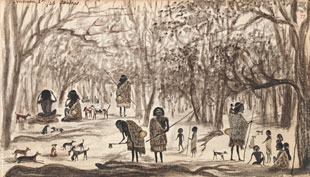Wiradjuri Gardeners
 |
|
| Wiradjuri women used digging sticks to harvest roots and tubers and find yams around the base of trees and shrubs. Although this painting shows an Aboriginal group in Victoria, the scene is typical of the way Wiradjuri people lived in this area. They used similar tools and dilly bags, and wore possum skin cloaks for protection against the cold. Major Thomas Mitchell observed Wiradjuri people carrying digging sticks like small shovels; one end was used to dig roots and tubers and the other to break open large anthills for the larvae. | |
| Image courtesy: Watercolour by Henry Godfrey, 1843. Pictures Collection, State Library of Vicitoria | |
In many ways the whole landscape around Mt Canobolas was a garden for Wiradjuri people. They knew every creek and spring in the area, following watercourses as they moved to seasonal hunting and camping grounds. The open woodlands admired by early explorers were maintained by fire stick farming. This encouraged the growth of grasses, which were harvested for their seeds, and the fresh green shoots attracted game. The whole food chain for Wiradjuri people was based on the plants and trees of the region.
Wiradjuri women were the first gardeners of the Orange district. They had a deep knowledge of bush foods and actively cultivated the land and managed food resources sustainably. Plants were harvested and processed for food, fibre and medicine. Food sources included fruit, seeds, berries, tubers, roots, leaves, nectar and bush honey. Bark, sedges and rushes were made into containers, baskets, nets and twine.
